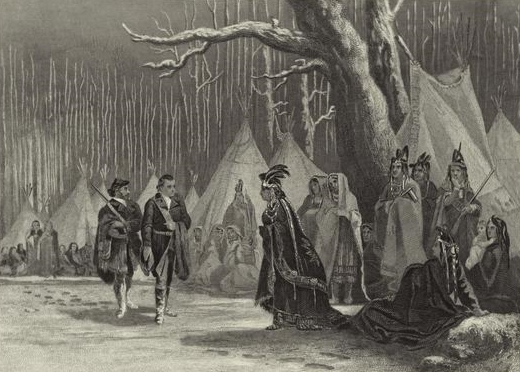This is a video by the American Battlefield Trust and they're at Valley Forge National Historical Park. Here are some of the recreated soldiers huts that George Washington's Continental Army would have lived in during the winter of 1777-1778.
Valley Forge
We see from the outside we have a roof, we have stacked logs that have notches in them known as saddle notches here. We also have between our logs um today what is cement but at the time would have been clay, hay, straw, everything together. We have a small chimney trying to make this as much of a log cabin or a home for 12 soldiers. Yes, 12 soldiers would live in this 14 by 16 hut.
We'll take a step inside for just a second. You can see how they would live in here on their bunks. You have a small fireplace where you would cook and you would have for heat. But 12 men would live inside of here. They would try to make it as comfortable as possible.
Sometimes you would find women in here. There are at least 400 women who are following the army here to Valley Forge. So this would be very cramped quarters if you're a soldier in Washington's army.
More about Valley Forge:
Valley Forge functioned as the third of eight winter encampments for the Continental Army's main body, commanded by General George Washington, during the American Revolutionary War. In September 1777, Congress fled Philadelphia to escape the British capture of the city. After failing to retake Philadelphia, Washington led his 12,000-man army into winter quarters at Valley Forge, located approximately 18 miles northwest of Philadelphia. They remained there for six months, from December 19, 1777 to June 19, 1778. At Valley Forge, the Continentals struggled to manage a disastrous supply crisis while retraining and reorganizing their units. About 1,700 to 2,000 soldiers died from disease, possibly exacerbated by malnutrition.
https://wikivisually.com/wiki/Valley_Forge
Valley Forge functioned as the third of eight winter encampments for the Continental Army's main body, commanded by General George Washington, during the American Revolutionary War. In September 1777, Congress fled Philadelphia to escape the British capture of the city. After failing to retake Philadelphia, Washington led his 12,000-man army into winter quarters at Valley Forge, located approximately 18 miles northwest of Philadelphia. They remained there for six months, from December 19, 1777 to June 19, 1778. At Valley Forge, the Continentals struggled to manage a disastrous supply crisis while retraining and reorganizing their units. About 1,700 to 2,000 soldiers died from disease, possibly exacerbated by malnutrition.
https://wikivisually.com/wiki/Valley_Forge




